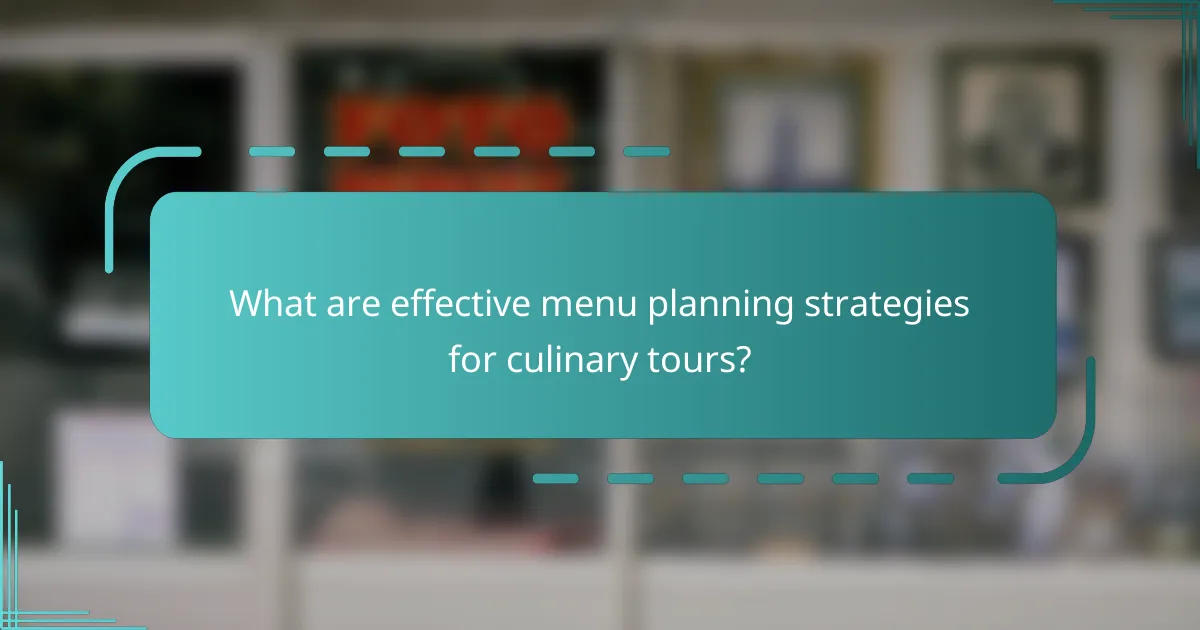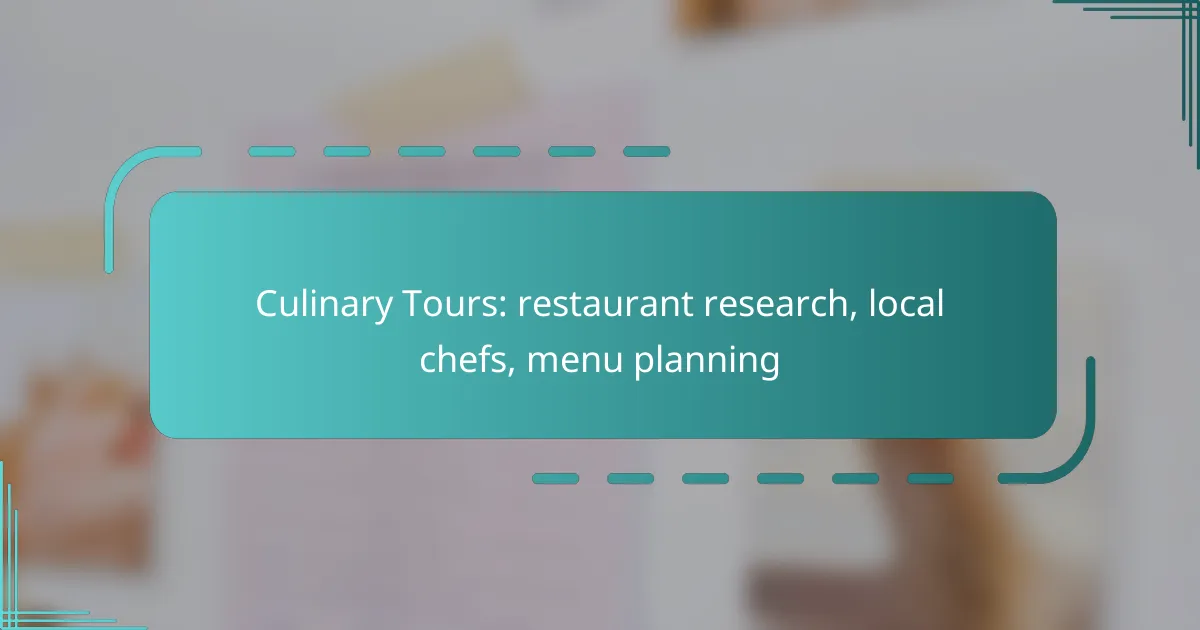Culinary tours provide an exciting opportunity to explore the rich tapestry of local cuisine through immersive experiences that showcase talented chefs and unique dining venues. By researching local chefs and their culinary styles, these tours can offer participants a deeper understanding of the area’s food culture. Thoughtful menu planning that emphasizes local flavors and seasonal ingredients further enhances the authenticity and enjoyment of each meal.

What are the best culinary tours in major cities?
The best culinary tours in major cities offer immersive experiences that highlight local cuisine, talented chefs, and unique dining venues. These tours typically include tastings, behind-the-scenes access, and insights into the culinary culture of the area.
New York City culinary tours
New York City is renowned for its diverse food scene, making it a prime destination for culinary tours. Popular options include food tastings in neighborhoods like Greenwich Village or Williamsburg, where you can sample everything from artisanal cheeses to international street food.
When choosing a tour, consider the focus—some may emphasize specific cuisines, while others highlight local history or chef-led experiences. Booking in advance is advisable, especially for popular tours that may sell out quickly.
San Francisco food experiences
San Francisco’s culinary tours often showcase its farm-to-table philosophy and rich cultural influences. Tours might include visits to local farmers’ markets, artisan bakeries, and renowned restaurants, allowing participants to taste fresh, seasonal ingredients.
Look for tours that offer small group sizes for a more personalized experience. Many tours also incorporate wine tastings from nearby Napa Valley, enhancing the overall gastronomic adventure.
Chicago restaurant tours
Chicago is famous for its deep-dish pizza and diverse culinary landscape. Culinary tours in the city often include stops at iconic eateries, food markets, and neighborhood gems, providing a comprehensive taste of Chicago’s food culture.
Consider tours that focus on specific themes, such as ethnic cuisines or classic Chicago dishes. Be sure to check for any dietary accommodations when booking, as many tours can cater to various preferences.
New Orleans culinary adventures
New Orleans offers culinary tours that delve into its unique Creole and Cajun cuisines. Participants can explore historic neighborhoods while sampling local specialties like gumbo, beignets, and po’boys, often guided by knowledgeable locals.
Look for tours that include cooking demonstrations or classes, which can provide hands-on experience. Given the city’s vibrant food scene, it’s wise to book tours that are well-reviewed to ensure a memorable experience.
Los Angeles food tours
Los Angeles culinary tours highlight the city’s eclectic food scene, from food trucks to upscale dining. Tours often focus on specific neighborhoods, such as Downtown LA or Santa Monica, where participants can enjoy a variety of flavors and styles.
When selecting a tour, consider the duration and the number of tastings included. Many tours also feature local chefs who share their insights, making for an engaging and educational experience.

How to research local chefs for culinary tours?
Researching local chefs for culinary tours involves identifying key figures in the local dining scene, understanding their culinary styles, and exploring their restaurant offerings. Focus on chefs who are well-regarded in their communities, as their expertise can greatly enhance the tour experience.
Top chef profiles in New York
New York is home to numerous acclaimed chefs known for their innovative approaches and diverse cuisines. Notable figures include Daniel Boulud, who specializes in French cuisine, and David Chang, known for his modern Asian dishes. Exploring their restaurants can provide a rich culinary experience.
When researching chefs in New York, consider their restaurant concepts, menu highlights, and any seasonal offerings. Many chefs also participate in local events or pop-ups, which can provide unique tasting opportunities.
Renowned chefs in San Francisco
San Francisco boasts a vibrant culinary scene with chefs like Thomas Keller, famous for his fine dining at The French Laundry, and Alice Waters, a pioneer of the farm-to-table movement. Their commitment to quality ingredients and local sourcing is a hallmark of the city’s dining culture.
To effectively research these chefs, look into their philosophies on food, any awards they have received, and their involvement in community initiatives. This insight can enhance your understanding of the local culinary landscape.
Local chefs to know in Chicago
Chicago’s culinary scene features prominent chefs such as Grant Achatz, known for his avant-garde cuisine at Alinea, and Stephanie Izard, who brings bold flavors to her restaurants. These chefs are influential in shaping the city’s gastronomic identity.
When exploring local chefs in Chicago, pay attention to their signature dishes and any collaborations with local farms or artisans. Engaging with their social media can also provide updates on special events or menu changes that might be of interest during your culinary tour.

What are effective menu planning strategies for culinary tours?
Effective menu planning strategies for culinary tours focus on utilizing local flavors, seasonal ingredients, and diverse dishes to create memorable dining experiences. By carefully selecting and pairing these elements, culinary tours can enhance the overall enjoyment and authenticity of the meals offered.
Seasonal menu planning
Seasonal menu planning involves designing menus that reflect the availability of fresh ingredients throughout the year. This strategy not only supports local farmers but also ensures that dishes are vibrant and flavorful. For example, summer menus might feature ripe tomatoes and fresh herbs, while winter menus could highlight root vegetables and hearty grains.
To implement seasonal planning, chefs should stay informed about local harvests and adjust menus accordingly. Regularly changing the menu can keep offerings exciting and encourage repeat visits from tourists eager to try new dishes.
Pairing local ingredients
Pairing local ingredients is essential for creating authentic culinary experiences during tours. Utilizing regional products allows chefs to showcase the unique flavors of the area, enhancing the connection between diners and the local culture. For instance, a culinary tour in Italy might highlight locally sourced olives, cheeses, and wines.
When selecting ingredients, consider sourcing from nearby farms and markets. This not only supports the local economy but also ensures freshness. Chefs should aim to incorporate a variety of textures and flavors, balancing rich and light elements to create well-rounded dishes.
Creating diverse tasting menus
Creating diverse tasting menus allows diners to experience a wide range of flavors and culinary techniques in a single meal. This approach is particularly effective for culinary tours, as it encourages exploration and discovery. A tasting menu might include small portions of several dishes, showcasing different cooking styles and local ingredients.
When designing a tasting menu, consider including a mix of appetizers, mains, and desserts, ensuring that each course complements the others. Aim for a balance of flavors, such as sweet, savory, and spicy, to keep the dining experience engaging. Additionally, offering wine or beverage pairings can elevate the tasting experience further.

What criteria should you consider when choosing a culinary tour?
When selecting a culinary tour, consider factors such as the tour duration, group size, and overall cost to ensure it meets your expectations and preferences. These elements will significantly influence your experience, from the depth of culinary exploration to the personal attention you receive.
Tour duration and schedule
The duration of a culinary tour can vary widely, typically ranging from a few hours to several days. Shorter tours may focus on specific meals or local markets, while longer tours often include multiple dining experiences and cooking classes. Assess your schedule and how much time you can dedicate to fully enjoy the culinary journey.
Additionally, check the tour schedule for flexibility. Some tours may offer set times, while others allow for adjustments based on your pace or interests. A well-structured itinerary can enhance your experience by ensuring you don’t miss key culinary highlights.
Group size and personalization
Group size plays a crucial role in the overall experience of a culinary tour. Smaller groups, typically ranging from 6 to 12 participants, allow for more interaction with local chefs and personalized attention. In contrast, larger groups may limit engagement and the ability to ask questions or receive tailored recommendations.
Look for tours that offer customization options. Some providers allow you to choose specific cuisines or activities, enhancing your culinary adventure. Personalized experiences can lead to memorable interactions and deeper insights into the local food culture.
Cost and value comparison
Cost is a significant factor when choosing a culinary tour, with prices often reflecting the quality of experiences offered. Basic tours may start at around $50, while more comprehensive experiences can exceed several hundred dollars. Evaluate what is included in the price, such as meals, transportation, and any special activities.
To assess value, compare different tours based on what they offer. Consider factors like the reputation of the chefs, the uniqueness of the culinary experiences, and any additional perks. Reading reviews and testimonials can provide insights into whether a tour delivers on its promises, helping you make an informed decision.

How do culinary tours benefit local economies?
Culinary tours significantly enhance local economies by promoting regional food culture and supporting various sectors. They create a ripple effect that boosts local businesses, increases tourism, and fosters community engagement.
Supporting local farmers
Culinary tours often prioritize local ingredients, which directly benefits farmers in the area. By sourcing produce, meats, and dairy from nearby farms, these tours help sustain agricultural practices and encourage the growth of local food systems.
This support can lead to stronger relationships between chefs and farmers, fostering a community that values fresh, seasonal produce. As chefs highlight local ingredients in their menus, they also educate tourists about the region’s agricultural heritage.
Boosting tourism revenue
Culinary tours attract food enthusiasts and travelers, significantly boosting tourism revenue. Visitors are drawn to unique dining experiences, local flavors, and cooking classes, which can lead to increased spending in restaurants, hotels, and local attractions.
In many regions, culinary tourism can account for a substantial portion of overall tourism income. For example, areas known for wine or specialty foods often see visitors who are willing to spend more on experiences that highlight local cuisine.
Creating jobs in the food industry
Culinary tours contribute to job creation within the food industry, from chefs and restaurant staff to tour guides and event organizers. As demand for culinary experiences grows, so does the need for skilled workers to meet this demand.
Additionally, these tours can stimulate job growth in related sectors, such as hospitality and agriculture. Communities that embrace culinary tourism often see a rise in employment opportunities, helping to strengthen the local economy.

What are the emerging trends in culinary tourism?
Emerging trends in culinary tourism focus on authentic local experiences, sustainability, and the integration of technology. Travelers increasingly seek immersive food experiences that connect them with local chefs and traditional cooking methods.
Focus on local ingredients
Many culinary tours now emphasize the use of locally sourced ingredients, reflecting a growing interest in sustainability and farm-to-table dining. This trend encourages chefs to create menus that highlight seasonal produce and regional specialties.
For example, a culinary tour in Italy might feature dishes made with fresh tomatoes, basil, and mozzarella sourced from nearby farms. This not only supports local economies but also enhances the flavor and authenticity of the dining experience.
Experiential dining
Experiential dining is becoming a hallmark of culinary tourism, where meals are paired with unique experiences. This could include cooking classes, vineyard tours, or even foraging excursions that allow travelers to engage directly with the food they consume.
For instance, a tour in France might offer a cooking class with a local chef, followed by a meal prepared using the techniques learned. Such experiences create lasting memories and a deeper appreciation for the culinary arts.
Technology integration
Technology is increasingly shaping culinary tourism, with apps and platforms facilitating connections between travelers and local chefs. These tools can help visitors discover dining options, book experiences, and even learn about the history of local dishes.
For example, mobile apps can provide real-time recommendations for nearby restaurants or food markets, enhancing the travel experience. Additionally, virtual cooking classes have gained popularity, allowing people to explore global cuisines from their homes.
